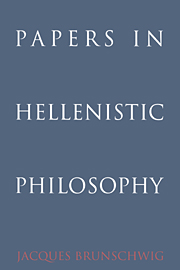Book contents
- Frontmatter
- Contents
- Acknowledgements
- Preface
- I EPICUREANISM
- II STOICISM
- III SCEPTICISM
- 9 Once again on Eusebius on Aristocles on Timon on Pyrrho
- 10 The title of Timon's Indalmoi: from Odysseus to Pyrrho
- 11 Sextus Empiricus on the κριτήριον: the Sceptic as conceptual legatee
- 12 The ὄσον ἐπὶ τῷ λόγῳ formula in Sextus Empiricus
- Bibliography
- Index of subjects
- Index of names
- Index of passages cited
10 - The title of Timon's Indalmoi: from Odysseus to Pyrrho
Published online by Cambridge University Press: 25 October 2009
- Frontmatter
- Contents
- Acknowledgements
- Preface
- I EPICUREANISM
- II STOICISM
- III SCEPTICISM
- 9 Once again on Eusebius on Aristocles on Timon on Pyrrho
- 10 The title of Timon's Indalmoi: from Odysseus to Pyrrho
- 11 Sextus Empiricus on the κριτήριον: the Sceptic as conceptual legatee
- 12 The ὄσον ἐπὶ τῷ λόγῳ formula in Sextus Empiricus
- Bibliography
- Index of subjects
- Index of names
- Index of passages cited
Summary
Timon of Phlius (about 325 to about 235), known as the Sillograph, was ‘spokesman’ (προϕήτης, Sextus Empiricus calls him, M 1.53) for his master Pyrrho of Elis. As his nickname indicates, he is known chiefly for his Silloi, a kind of Homer in disguise into which he had poured all his satirical verve, in the service of Pyrrho. In the fragments by him that have come down to us, the Silloi predominate, thanks to their dashing style and the many explicitly personal attacks directed against a large number of well-known and respected philosophers that they contain. Quite a few fragments of this work are thus preserved, and their spiciness still comes through, despite the sophistication of the vocabulary and the obscurity of the allusions. We also possess an equally valuable and quite detailed general description of the structure of the work and its author's intentions.
However, the Silloi by no means constitute the entire output of the Sillograph. The fragments that remain from Timon's writings testify fully to his many-sided ability. He was an enormously prolific author, who had written in the most varied of genres. Diogenes Laertius (ix.iio–ii) provides the following information on him:
He was known to King Antigonus and to Ptolemy Philadelphia, as his own Iambi (ἐν τοῖς ἰάμβοις) testify. He was, according to Antigonus [of Carystus], fond of wine, and in the leisure time that he could spare from philosophy, he used to write poems. […]
- Type
- Chapter
- Information
- Papers in Hellenistic Philosophy , pp. 212 - 223Publisher: Cambridge University PressPrint publication year: 1994
- 1
- Cited by



